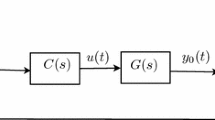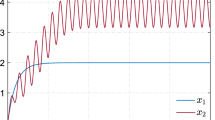Abstract
An original method for modeling, simulation and identification of fractional systems in the time domain is presented in this article. The basic idea is to model the fractional system by a state-space representation, where conventional integration is replaced by a fractional one with the help of a non-integer integrator. This operator is itself approximated by a N-dimensional system composed of an integrator and of a phase-lead filter. An output-error technique is used in order to estimate the parameters of the model, including the fractional order N. Simulations exhibit the properties of the identification algorithm. Finally, this methodology is applied to the modeling of the dynamics of a real heat transfer system.
Similar content being viewed by others
References
Baron, C., ‘Contribution à l’estimation de paramètres physiques à l’aide de modèle d’ordre réduit’, Thèse de Doctorat, Université de Poitiers, France, 2003.
Battaglia, J. L.,‘Méthodes d’identification de modèles à dérivées d’ordres non entiers et de réduction modale. Application à la résolution de problèmes thermiques inverses dans des systèmes industriels’, Habilitation à Diriger des Recherches, Université de Bordeaux I, France, 2002.
Beran, J.,‘Statistical methods for data with long-range dependance’, Stastical Science7,1992, 404–427.
Chen, Y. and Moore, K. L.,‘Discretization schemes for fractional differentiators and integrators’, IEEE Transactions on Circuits and System 1: Fundamental Theory and Applications49(3), 2002, 363–367.
Cois, O.,‘Systèmes linéaires non entiers etidentification par modèle non entier: application en thermique’, Thèse de Doctorat, Université de Bordeaux I, France, 2002.
Dorcak, L., Lesko, V., and Kostial, I.,‘Identification offractional order dynamical systems’, in Proceedings of the 12th International Conference on Process Control and Simulation, Kosice, Slovak Republic, 1996, pp. 62–68.
Feliu, V. and Feliu, S.,‘A method of obtaining the time domain response of an equivalent circuit model’, Journal of Electroanalytical Chemistry435, 1997, pp. 1–10.
Fliess, M. and Hotzel, R.,‘Linear systems with a derivation of non-integer order: introductory theory with an example’, in Proceedings CESA’96 Sympsium on Model, Analysis and Simulation, Vol. 1, Lille, France, 1996, pp. 213–217.
Garcia, G. and Bernussou, J.,‘Identification of the dynamics of a lead-acid battery by a diffusive model’, in ESAIM Proceedings Systèmes Différentiels Fractionnaires, Paris, 1998.
Heleschewitz, D. and Matignon, D.,‘Diffusive realisations of fractional integrodifferential operators: structural analysis under approximation’, in Proceedings of IFAC Conference System, Structure and Control, Nantes, France, 1998, pp. 243–248.
Ichise, M., Nagayanagi, Y., Kojima, T., ‘An analog simulation of non-integer order transfer functions for analysis of electrode processes’, Journal of Electroanalytical Chemistry Interfacial Electrochem33, 1971, 253.
Khaorapapong, T.,‘Modélisation d’ordre non entier des effets de fréquence dans les barres rotoriques d’une machine asynchrone’, Thèse de Doctorat, INP Toulouse, France, 2001.
Le Lay, L., Oustaloup, A., Trigeassou, J.-C., and Levron, F.,‘Frequency identification by non-integer model’, in Proceedings of IFAC Conference System, Structure and Control, Nantes, France 1998, pp. 297–302.
Le Lay, L., Oustaloup, A., Trigeassou, J.-C., and Levron, F.,‘Frequency identification by implicit differentiation models’, in Proceedings of AVCS’98 International Conference on Advance in Vehicle Control and Safety, Amiens, France, 1998, 351–356.
Levy, E. C.,‘Complex curve fitting’, IRE Transactions on Automatic Control4, 1959, 37–43.
Lin, J. and Poinot, T.,‘Modélisation de systèmes d’ordre non entier’, in Proceedings of JDA’99 Journées Doctorales d’Automatique, Nancy, France, 1999,pp. 53–56.
Lin, J., Poinot, T., Trigeassou, J. C., Kabbaj, H., and Faucher, J.,‘Modélisation et identification d’ordre non entier d’une machine asynchrone’, in Proceedings of CIFA’2000, Conférence Internationale Francophone d’Automatique, Lille, France, 2000.
Lin, J., Poinot, T., Trigeassou, J. C. and Ouvrard, R.,‘Parameter estimation of fractional systems: application to the modeling of alead-acid battery’, in Proceedings of SYSID 2000, 12th IFAC Symposium on System Identification, Santa Barbara, California, 2000.
Lin, J., Poinot, T., Trigeassou, J. C., and Coirault, P.,‘Parameter estimation of fractional systems. Application to heat transfer’, in ECC 2001, European Control Conference, Porto, Portugal, 2001, pp. 2644–2649.
Lin, J., ‘Modélisation et identification de systèmes d’ordre non entier’, Thèse de Doctorat, Université de Poitiers, France, 2001.
Ljung, L.,‘System Identification – Theory for the User’, T. Kailath (ed.), Prentice Hall, Upper Saddle River, New Jersey, 1987.
Marquardt, D. W.,‘An algorithm for least-squares estimation of non-linear parameters’, Journal of Society Industrial Applied Mathemetics11(2), 1963, 431–441.
Miller, K. S. and Ross, B., An Introduction to the Fractional Calculus and Fractional Differential Equations. Wiley, New York, 1993.
Montseny, G., ‘Diffusive representation of pseudo-differential time-operators’, in Proceedings Fractional Differential Systems: Models, Methods and Applications, Paris, 1998.
Oustaloup, A., Systèmes asservis linéaires d’ordre fractionnaire, Masson, Paris, 1983.
Oustaloup, A., La dérivation non entière: théorie, synthèse et applications, Hermès, Paris, 1995.
Poinot, T., and Trigeassou, J. C., ‘Parameter estimation of fractional models: Application to the modeling of diffusive systems’, inProceedings of 15th IFAC World Congress,Barcelona, Spain, 2002.
Poinot, T. and Trigeassou, J. C., ‘A method for modeling and simulation of fractional systems’, Signal Processing: Special Issue on Fractional Signal Processing and Applications 83, 2003, 2319–2333.
Raynaud, H. F., and Zergainoh, A., ‘State-space representation of fractional linear filters’, in Proceedings of IFAC Conference System Structure and Control, Nantes, France, 1998.
Retière, N. and Ivanes, M., ‘Modeling of electric machines by implicit derivative half-order systems’, IEEE Power Engineering Review, September, 1998, 62–64.
Richalet, J., Rault, A., and Pouliquen, R., ‘Identification des Processus par la Méthode du Modèle’, Gordon and Breach, Paris, 1971.
Tenreiro Machado, J. A.,‘Discrete-time fractional-order controllers’, in Proceedings of IEEE-INES’2000, 4th International Conference on Intelligent Engineering Systems, Portoroz, Slovenia, 2000.
Author information
Authors and Affiliations
Corresponding author
Rights and permissions
About this article
Cite this article
Poinot, T., Trigeassou, JC. Identification of Fractional Systems Using an Output-Error Technique. Nonlinear Dyn 38, 133–154 (2004). https://doi.org/10.1007/s11071-004-3751-y
Received:
Accepted:
Issue Date:
DOI: https://doi.org/10.1007/s11071-004-3751-y




